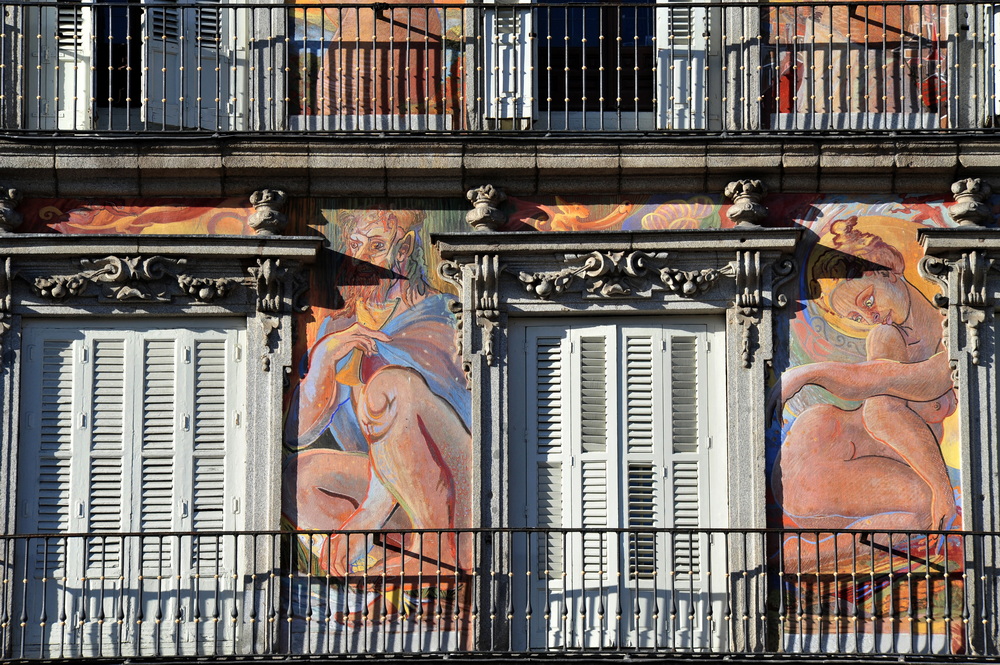Here is our rundown of the best Madrid neighborhoods and what makes each one special. Living in Madrid is a fabulous experience for many Expats. Cosmopolitan yet uniquely Spanish. Vibrant, cultured, and gastronomic. If you have already decided t make the move, the next step is deciding which neighborhood is for you.
The 6 Best Madrid Neighborhoods to Live In
1. Malasaña: Best Madrid Neighborhood For 20-Something Hipsters
In the 18th century, Malasaña became a popular destination for artists and intellectuals. This bohemian hotspot continued in popularity into the 20th century and became a center of the Spanish counterculture movement in the 1970s. Today it is a bustling and trendy neighborhood full of 20-somethings from around the world. It has a vibrant nightlife scene and countless cool bars and eateries. Trendy boutiques and vintage stores abound. Missing the beach? No problem. Head downstairs at Ojala, and you will find an indoor beach bar replete with sand, deck chairs, and cocktails.
Pros and Cons of Living in Malasaña
Malasaña is a fun place to be at any time of day or night. If you came to Madrid to experience its nightlife and energy, this could be the place for you. It is very central and has easy access to everywhere via the Metro. Definitely one of the best Madrid neighborhoods for young international travelers.
On the downside, it may not be ideal for families. It is a tightly packed neighborhood of tall buildings converted into flats. You are highly unlikely to find a spacious apartment or house with a pool here. Green spaces are limited. The nightlife makes it noisy. And you are nowhere near the international schools.
2. Chueca: Best neighborhood in Madrid for LGBTQ+
Chueca is renowned as a vibrant and diverse neighborhood. It is known for its LGBTQ+-friendly atmosphere, lively nightlife, and colorful streets. Chueca is a great place to live for young people who are looking for a welcoming and inclusive community. It features museums, theatres, good restaurants, and a lively bar and club scene.
Pros and Cons of Living in Chueca
Similar to Malasana, this is a great place to live for young people with no children. There is always something to do, and it is very inclusive. Many organizations and events add to that sense of community. It is very central and has great transport links.
But again, it is noisy, tightly packed, and far from the international schools. Rents are expensive and are generally for small apartments.
3. Salamanca: The Best Madrid Neighborhood for Wealthy Families
If you are looking for somewhere a little more dignified, Salamanca could be the upscale neighborhood for you. If your budget can stretch to it! It is one of the most expensive districts in Madrid, as you can guess from its high-end shopping and Michelin-starred restaurants. Looking for Gucci, Vuitton, and Chanel? You’ve come to the right place.
The district is also home to several cultural attractions, such as the National Archaeological Museum and the Lázaro Galdiano Museum. Salamanca is a popular neighborhood for both bourgeois madrileños and wealthy expats alike.
Pros and Cons of Living in Salamanca
This is the place for those with large budgets only. Struggling travelers need not apply. It is ideal for expat families as it is home to several international schools. These include The American School of Madrid, the British Council School of Madrid, and Colegio Montessori. It boasts beautiful parks, good hospitals, gyms, and libraries. It is central and easily accessible by public transport.
The main con is the cost of living in an upscale neighborhood. And if you prefer vintage to Vuitton, this area may be a bit bland and too chi-chi for your tastes.
4. Charmartin: Best for Young Families
Chamartín is a quiet residential neighborhood north of Madrid. It is well-connected and contains Chamartín Station, Madrid’s second-largest train station. The home of Real Madrid is located here at Santiago Bernabéu Stadium. It also contains the four tallest skyscrapers in Spain. And the National Auditorium of Music (the main concert hall in Madrid). It is not as historic as the more central neighborhoods. However, it has beautiful parks and green spaces, making it one of the best Madrid neighborhoods.
Pros and Cons of Living in Charmartin
Most apartment buildings have communal gardens with swimming pools, making them ideal for families with kids. Several international schools are in the area, including King’s College, The British School of Madrid, St. George’s International School, Colegio Internacional SEK, and another Colegio Montessori. It is still expensive but not in the same league as Salamanca. It offers a good lifestyle for families. But again, if you are hankering after vibrant city life, this may be a little tame for you.
5. Downtown Madrid: Best for Urbanites
If only the most urban will do, then Centro Madrid is the spot for you. Centro is the historic center of Madrid. It is home to many of the city’s most famous landmarks, including the Royal Palace, the Plaza Mayor, and the Retiro Park. Centro is also a vibrant and exciting neighborhood with a wide variety of restaurants, bars, and shops.
Pros and Cons Living in Downtown Madrid
Living in Centro has many advantages. You will be close to all the action and have easy access to the city’s best attractions. You will also be surrounded by history and culture. However, there are also some disadvantages to living in Centro. Rent prices are high, and the neighborhood can be crowded and a little noisy. Some families prefer areas with more space and less buzz.
6. Chamberi: A Great Compromise That Suits Everyone
Chamberí is located in the heart of Madrid, making it easy to get around the city. You’re just a short walk or metro ride from all the major attractions, including the Prado Museum, the Retiro Park, and the Gran Vía.
Pros and Cons of Living in Chamberi
It is a very diverse neighborhood, with people from all over the world living there. With a slower pace of life than some trendy neighborhoods, it is a great place for a relaxing lifestyle near the center of this vibrant city. Chamberí has a wide variety of housing options to choose from, including apartments with communal pools, houses, and even some converted palaces. All this adds to its charm as one of the best Madrid neighborhoods. On the downside, it is still a pricey area with few green spaces.
Other notable neighborhoods
- For hipsters. Along with Malasana and Chueca, there are cool neighborhoods such as La Latina, Lavapies, and Sol. A little cheaper than the first two, any of these diverse districts will give you plenty of nightlife, trendy shops, and great food. Lavapies, in particular, is a good option if you seek a hipster vibe without the price tag.
- For families, Retiro is another very desirable location for wealthy families. It is central and contains Retiro Park, so it has plenty of green space. But it is still very expensive. Pozuelo and Aravaca are two twin suburbs that have a lot to offer international families. Affluent and easily accessible (7 minutes by train from the city center), there are several good international schools. Retiro also has many green spaces and an active community vibe.
Find Your Perfect Rental Property in Madrid
The Madrid rental market can be tough to navigate, especially from afar. Our housing expert in Madrid, Eliana, will work exclusively for you. With deep local knowledge and firsthand experience as an expat, she guides clients through every step — from tailored property searches to settling into the community.
Areas of Madrid – Map
The Madrid Local Government (Ayuntamiento de Madrid) has an awesome online map portal. You can explore all sorts of information.
Here’s a sample map of Madrid’s neighborhoods, but feel free to head to the Geoportal del Ayuntamiento de Madrid for more.

How to choose your Madrid Neighborhood
- When choosing which is the “best” Madrid neighborhood, it’s really all about you and your lifestyle. What’s right for a young student might be a huge turn-off if you have small children or want a little peace and quiet.
- We have given you a taster of what these Madrid neighborhoods have to offer. But we recommend you visit and get a feel for it yourself before plunging in. Renting a short-term let in one or more of your shortlisted areas is a great idea.
- You can also talk to locals, join social media groups, and read online forums to get a real feel for living in a particular Madrid neighborhood.
Our tip: One great way to learn more about a neighborhood is to explore it on foot. Take a walk around the area to get a sense of the atmosphere and see what kinds of shops and restaurants are available. Take in the sounds, sights, and smells!
Renting a property in your Madrtid Neighborhood
Madrid’s rental market can be competitive, especially in popular neighborhoods. It’s a good idea to start your search early and be prepared to act quickly if you find a place you like. You may also want to work with a local real estate agent who can help you navigate the rental market and find the best options for your needs.
See our guide to Renting a Property in Spain.
Next steps for Moving to Madrid
There’s beauty, good living, and fun times all across this magnificent city. You now have the best Madrid neighborhoods all lined up; which will you choose?
Find Your Perfect Property in Madrid
Navigating the property market in Madrid can be tricky—especially from abroad. Work with Angelica, an experienced buyer’s agent who will represent your interests every step of the way. With has deep knowledge and real estate connections throughout Madrid and as native Spanish speaker, Angelica will make the home-finding process stress-free for you and your family.








I am a single female, age 60, looking to move to Spain. I am looking for a place where I can comfortably have pets and feel safe. I am on disability which limits my ability to sit. Walking is great for my back so that is not an issue. I want out of the US to start a new life. I grew up in Puerto Rico so learning a new Spanish dialect shouldn’t be an issue. I am looking to buy a small house. What are your recommendations on the best place to live? How difficult is it to get a visa? Please send me as much advice as possible since I will be doing all of this alone.
Regards,
Melanie Fiala
Hi Melanie. If oyu’re looking for help finding the b3est place in Madrtid, our partner Angelica is able to assist, you can book a consultaiotn here > https://movingtospain.com/housing-resources/angelica-miller/ All the best, Alastair